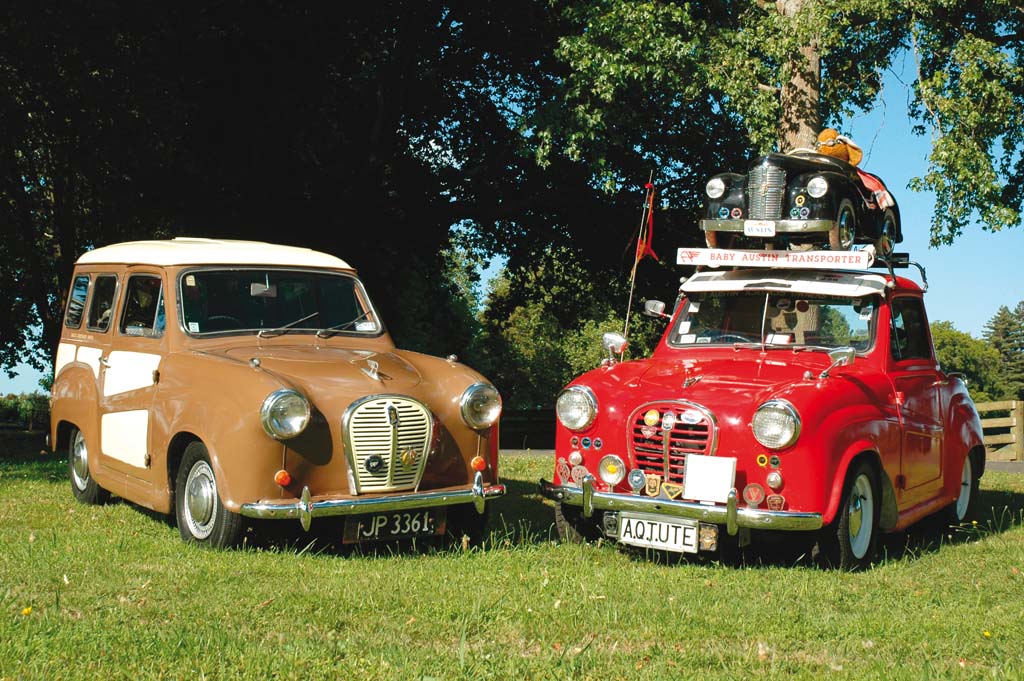data-animation-override>
“Published in New Zealand Classic Car Issue No. 211”

Tim travels to Morrinsville to meet a couple waving the ¨‘flying A’ flag for some of the cutest commercial classics ever made
Several years ago when I was collating photos for my book, Utes & Pickups in New Zealand, I heard about a guy in the Waikato who collected everything to do with Austin cars and who was using a rare Austin A35 pick-up as an everyday runner. Both my father, who drives an Austin A40 Farina, and Graham Elstone, who was then racing an Austin A35 in classic car racing, told me I had to catch up with Kevin Heyward. I corresponded with Kevin, who kindly sent me a photograph of his rare little pick-up, but years seemed to lapse before I could actually squeeze in a trip to Morrinsville. By the time I had made the drive from Taranaki to Cambridge and then over the hills to Morrinsville, Kevin and his wife Gaye had acquired yet another Austin A35 to add their collection, which had by now also stretched to an Austin-Healey Sprite and various Austin saloons.
My interest had also been heightened because I had heard that the A35 van the Heywards had just purchased was a van I had seen travelling around Hawera when I was a teenager, a carpentry runabout from Wallis, a cabinetmaker.
Everyman’s Utility
Old Austin adverts for the Austin A35 pick-up read, “The Austin A35 Pickup — Everyman’s utility car,” yet by the time the model was phased out of production, only 475 are known to have been built. However, prototypes and vehicles created from spare bodies post-production could inflate this figure slightly.
Designed through the pen of Argentinean-born Dick Burzi, who was responsible for the whole Austin A30/A35 series of vehicles, the little pick-up was sent all over the planet as part of Austin’s big export drive. Only 241 A35 pick-ups were sold in the UK home market while the rest went overseas, including some in left-hand drive form, to places such as Chile (48 examples), Asia and the Pacific Islands (23), Sudan (nine), Rhodesia (now Zimbabwe, 27), The West Indies (11), Canada (five) and New Zealand (17). Several countries, such as South Africa, Denmark, Gibraltar, Malawi and Kuwait, received less than five of the pick-ups each.
From all this widespread Austin diaspora, by 1992 — from Austin club figures — only 57 Austin A35 pick-ups could still be accounted for. By Kevin Heyward’s reckoning around 11 or 12 are still thought to survive in New Zealand, not all of them currently roadworthy.
The Heywards’ well-travelled pick-up is build number PV87, which was first sent from Britain to Fiji before arriving in New Zealand in 1962. Another came to New Zealand via Rarotonga. Kevin and Gaye’s pick-up from the Suva Trading Company is an unusual version in that it came with pressed doors like the van versions. Fisher Ludlow pressed the bodies and then they were returned to Austin which assembled them. When Kevin bought his now much travelled Austin pick-up it had slightly flared rear guards, an alteration carried out by the vehicle’s previous owner, Bradley’s Towing & Panel of Westmere, which had been using it as a company runabout.
Well travelled
Kevin and Gaye have kept the pick-up in pretty much the same set-up as when it was purchased, and it has served them for many, many kilometres on ‘Flying A’ Austin car club rallies and All British Day events.
As I looked over the well-travelled A35, I ruminated on the low production run of what seemed an appealing or cute little ute. Kevin’s theory is that while the vehicle has its own charm and lovely lines the lack of a tailgate could have been its downfall. “No-one really wanted to buy them,” Kevin said. “It was basically because of the lack of a tailgate — without it the British Government taxed the pick-ups as cars, which were dearer.”
After viewing the pick-up, I noticed an older Austin A30 sitting in a corner of the Heywards’ vast garage.
“That’s a rare AS3 model,” Kevin said, “dating from 1953 — one of the very first to come out to New Zealand. It was the promotional car for Seabrook-Fowlds and only the second one it ever sold. These early ones are identifiable by their internal boot hinges, which proved a poor design in the wet as the way the boot opens water can get in.”
James Hunt’s Everyday Drive
Growing up as a teenager in the late ’70s, I followed Formula One closely during the Lauda/Hunt rivalry era and afterwards followed the lives of my heroes. I was always intrigued that James Hunt used an Austin A35 van as his everyday drive between tending to his caged birds.
I had the late James Hunt in mind as I ventured toward one of the Heywards’ other collectable Austins, the former Wallis Cabinetmakers A35 van — still in working livery from its old Hawera days. I may not be likely to ever pilot a Marlboro-McLaren M23, but as for that other vehicle James Hunt ¨drove with pleasure — an Austin A35 van — well, I was about¨to drive one.
Kevin handed me the keys to the old Wallis van while he and Gaye donned their Austin hats and proceeded to prepare to lead me on a mini-tour of part of Morrinsville. I had driven my parents’ Austin A40 Farina quite a bit, but had never powered off the mark in a precursor A30/35 variant.
Just like the later MkI A40 Farina, the A35s are powered by the famous little Austin A-series engine, in 948cc specification. Farinas rev quite freely right up to about 5000rpm, and even today are peppy, economical and very usable classics. The A35 van proved no different as I gave the little Austin plenty of revs before easing off and following behind Kevin and Gaye, who were packed into the pick-up with all their Austin paraphernalia.
As with the A40 and the old Riley 4/72 I once owned for 20 years, the steering was soft due to the old-style Austin cam and peg set-up, but when you point the little Austin in the direction of a corner, providing its suspension is tight, they will still head where they are supposed to. The chromed flying A proudly situated atop the bonnet, a remembrance of Herbert Austin’s motoring contribution, gives one a gun-sight with which to take aim at the road ahead.
Despite being over 50 years old the A35 was sprightly and powered along with relative gusto, showing occasional minor body roll on bends and an eagerness to perform well within its 4750rpm range. Sucking freely through a Zenith carburettor, the A-series and its 25kW (34bhp) was adequate for motoring along in acceptable fashion, but I did wonder how well the van would perform fully laden with tradesman’s tools or goods. Nonetheless as a usable everyday classic, for going shopping or on Austin rallies, the A35 van would be just fine. A couple would have plenty of room to throw a tent and luggage in the rear while travelling long distance within a tight fuel budget as, according to early road tests, the A35 range returned around 7.4 litres per 100km (38mpg). Back at the Heywards’ Morrinsville abode, where an Austin grille serves as a water feature and diecast Austins park in cabinets, I also managed to take a quick look at the Heywards’ Sprite and a tidy Austin A55.
Austin Disease
“The Austin disease got me,” Kevin said. “I started out learning to drive in an old EIP Vauxhall Wyvern, and the best car I ever owned was actually a Holden — a ’58 FC wagon — but after I bought my son an old AS3 Austin A30 to take to university I found that I liked it too much to let it go, and kept it for myself. From then on it’s just been, well, as I said, a kind of Austin disease!” Kevin then came over all glassy-eyed as he recalled his FC Holden.
“That old FC was an Australi
an assembled one in a pinkish maroon and cream colour scheme, with chromed wording on the spats and with Venetian blinds — all the Aussie extras! I often wonder where it went, and that Holden is the one car I might give up my whole Austin collection to have again!”
Quite frankly, I’m glad Kevin has had his life directed down the Austin path, because he and Gaye are enthusiastic champions of one of the greatest British motoring marques.
At home in Morrinsville they have a unique collection of Austin memorabilia, and a unique pair of classic 1957 Austin commercials.
Words & Photos: Tim Chadwick



















